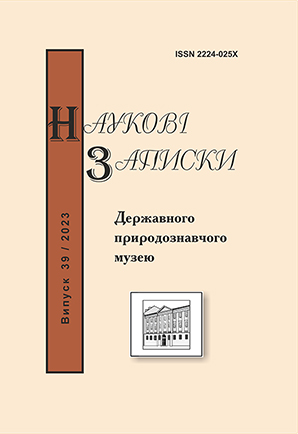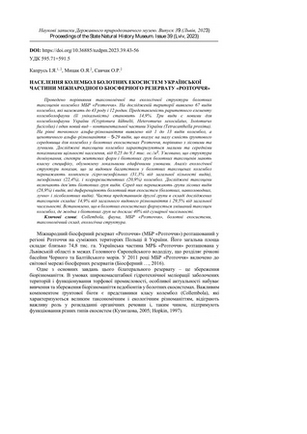Kaprus I.Ya., Mytsak O.Ya, Savchak O.R.
Population of Collembola of bog ecosystems of the ukrainian part of the International Biosphere Reserve «Roztochia» // Proc. of the State Nat. Hist. Mus. - Lviv, 2023. - 39. - P. 43-56 DOI: https://doi.org/10.36885/nzdpm.2023.39.43-56 Key words: Collembola, fauna, MBR «Roztochiа», bog ecosystems, taxonomic composition, ecological structure A comparative analysis of the taxonomic and ecological structure of bog collembolan taxocenes of IBR "Roztochia" was carried out. 67 species of Сollembola belonging to 43 genera and 12 families were found on the studied territory. The representation of the rare element of collembolofauna (its uniqueness) is 14.9%. Three species are new to the collembolofauna of Ukraine (Cryptonura kühnelti, Heteromurus sexoculatus, Isotomurus fucicolus) and one new species is from the continental part of Ukraine (Tetracanthella proxima). From 1 to 13 species of Сollembola were found at the level of point alpha diversity, and 5–29 species of coenotic alpha diversity, which indicates a small capacity of the soil environment for Сollembola in bog ecosystems, сompared to forest and meadow ecosystems. The investigated bog Collembola taxocenes are characterized by small and average population density indicators, from 0.25 to 9.1 thousand spec./m2. It was found that the structure of dominance, spectra of life forms and biotope groups of the studied taxocenes have their own specificity, due to local edaphic conditions. The analysis of the ecological structure showed that, in terms of species richness, complexes of hygro-mesophilic (31.3% of the total species richness), mesophilic (22.4%) and xeroresistant forms (20.9%) prevail in bog taxocenes of collembola. The studied taxocenes include nine biotope groups of species. The biotope groups of forest species (28,9%) and species that differentiate the bog type of ecosystems (bog, near-water, meadow- and forest-bog species) prevails. The share of representatives of the second group in the studied taxocenes is 14.9% of the total species diversity and 29.5% of the total abundance. It was established that a mixed collembolan taxocene is formed in bog ecosystems, where none of the biotope groups reaches 40% of the total abundance.
Population of Collembola of bog ecosystems of the ukrainian part of the International Biosphere Reserve «Roztochia» // Proc. of the State Nat. Hist. Mus. - Lviv, 2023. - 39. - P. 43-56 DOI: https://doi.org/10.36885/nzdpm.2023.39.43-56 Key words: Collembola, fauna, MBR «Roztochiа», bog ecosystems, taxonomic composition, ecological structure A comparative analysis of the taxonomic and ecological structure of bog collembolan taxocenes of IBR "Roztochia" was carried out. 67 species of Сollembola belonging to 43 genera and 12 families were found on the studied territory. The representation of the rare element of collembolofauna (its uniqueness) is 14.9%. Three species are new to the collembolofauna of Ukraine (Cryptonura kühnelti, Heteromurus sexoculatus, Isotomurus fucicolus) and one new species is from the continental part of Ukraine (Tetracanthella proxima). From 1 to 13 species of Сollembola were found at the level of point alpha diversity, and 5–29 species of coenotic alpha diversity, which indicates a small capacity of the soil environment for Сollembola in bog ecosystems, сompared to forest and meadow ecosystems. The investigated bog Collembola taxocenes are characterized by small and average population density indicators, from 0.25 to 9.1 thousand spec./m2. It was found that the structure of dominance, spectra of life forms and biotope groups of the studied taxocenes have their own specificity, due to local edaphic conditions. The analysis of the ecological structure showed that, in terms of species richness, complexes of hygro-mesophilic (31.3% of the total species richness), mesophilic (22.4%) and xeroresistant forms (20.9%) prevail in bog taxocenes of collembola. The studied taxocenes include nine biotope groups of species. The biotope groups of forest species (28,9%) and species that differentiate the bog type of ecosystems (bog, near-water, meadow- and forest-bog species) prevails. The share of representatives of the second group in the studied taxocenes is 14.9% of the total species diversity and 29.5% of the total abundance. It was established that a mixed collembolan taxocene is formed in bog ecosystems, where none of the biotope groups reaches 40% of the total abundance.
References
- Біосферний резерват «Розточчя». 2016. Львів : Департамент екології та природних реурсів Львівської облдержадміністрації. 40 с.
- Капрусь И.Я. 1990. Фауна ногохвосток (Collembola) поймы реки Верещицы. Каталог музейных фондов. Сборник научных трудов. Львів. С. 102–124.
- Капрусь И.Я. 2003. Ногохвостки (Collembola) Волыно-Подолья, в Чернобай Ю. и др. Экология и фауна беспозвоночных западного Волыно-Подолья. Київ : Наук. думка. С. 100 –172.
- Капрусь І.Я. 2010. Таксономічна структура і типологія регіональних фаун ногохвісток (Collembola) Євразії. Наукові записки Державного природознавчого музею. Вип. 26. С. 39–50.
- Капрусь І.Я. 2013. Хорологія різноманіття колембол (філогенетичний, типологічний і фауністичний аспекти). Дисертація доктора наук, Інститут зоології НАН України. Київ. 497 с.
- Капрусь І.Я., Гоблик К.М. 2015. Екологічна та созологічна оцінка ґрунтів Закарпатської низовини за угрупованнями колембол. Наукові записки Державного природознавчого музею. Вип. 31. С. 45–58.
- Капрусь І.Я., Махлинець Т.М. 2015. Особливості фауни й населення колембол правобережного сектору лісостепової зони України. Наукові записки Державного природознавчого музею. Вип. 31. С. 59–72.
- Кузнецова Н.А. 2005. Организация сообществ почвообитающих коллембол. Москва : ГНО Прометей. 244 с.
- Стебаева С.К. 1970. Жизненные формы ногохвосток (Collembola). Зоол. журн. Т. 44 № 10. С. 1437–1454.
- Чернобай Ю.Н., Капрусь И.Я., Меламуд В.В., Ризун В.Б. 2003. Педокомплексы беспозвоночных в системе биогеоценотических связей. В: Чернобай и др. Экология и фауна беспозвоночных западного Волыно-Подолья. Київ : Наук. думка. С. 271–354.
- Bellinger P.F., Christiansen K.A., Janssens F. 1996–2023. Checklist of the Collembola of the World [online]. Доступне http://www.collembola.org [Дата звернення 16 травня 2023 року].
- Czachorowski S., Buczyński P. 2000. Zagrożenia i ochrona owadów wodnych w Polsce. Wiadomości Entomologiczne. Vol. 18, Supl. 2. P. 95–120.
- Dunger W., Fiedler H.J. (Hrsg.) 1997. Methoden der Bodenbiologie. Gustav Fischer Verlag Jena, Villengang. 539 pp.
- Hopkin S.P. 1997. Biology of the springtails (Insecta: Collembola). Oxford, New York, Tokyo : Oxford University press. 330 pp.
- Hammer I., Harper D.A.T., Ryan P.D. 2001. PAST: Paleontological Statistics Soft ware Package for Educationand Data Analysis [online]. Palaeontologia Electronica. Vol. 4 № 1. 9 p. Доступне: http://palaeo-electronica.org/2001_1/past/issue1_01.htm [Дата звернення 16 травня 2023 року].
- Kaprus I.J. 1998. The fauna of springtails (Collembola) from selected habitats in Roztocze. Fragmenta faunistica. Vol. 41 No 3. P. 15–28. MagurranA.E. 2004. Measuring Biological Diversity. Blackwell Publishing Ltd, UK. 256 pp.
- Oleksa A. 2003. Wymagania środowiskowe i struktura metapopulacji dostojki akwilonaris Boloria aquilonaris Stichel, 1908 (Lepidoptera, Nymphalidae) na Pojezierzach Iławskim i Olsztyńskim. Rozprawa doktorska. Toruń : Instytut Ekologii i Ochrony Środowiska UMK. 80 s.
- Sławska M., Sławski M. 2009. Springtails (Collembola, Hexapoda) in Bogs of Poland. Warsaw : Warsaw University of Life Sciences Press. 83 p.
- Sterzyńska M. 2002. Collembola of the hydrogenic soils of Biebrza River valley, in Studies on Soil Fauna in Central Europe (Tajovský, K., Balik, V., Pižl V. red.). České Budějovice : Institute of Soil Biology ASCR. P. 207-212.
- Sterzyńska M. 2009. Assemblages of soil Collembola in wetlands in the floodplains of some Polish rivers. Warszawa : Museum and Institute of Zoology PAS. 96 p.
- Spitzer K., Jaros J. 1993. Lepidoptera associated with the Cervene Blato (Central Europe): Conservation implication. European Journal of Entomology. Vol. 90. P. 323–336.
- Stöcker G., Bergmann A. 1977. Ein Modell der Dominanzstruktur und seine Anwedung. In Modellbildung, Modellrealisierung, Dominanzklassen. Archiv für Naturschutz und Landschaftsforschung. B. 17 No 1. S. 1–26.
- Väisänen R. 1992. Distribution and abundance of diurnal Lepidoptera on a raised bog in southern Annales Zoologici Fennici. Vol. 29. P. 75–92. Whittaker R.H. 1977. Evolution of species diversity in land communities. Evolutionary Biology. Vol. 10. P. 1–67.


